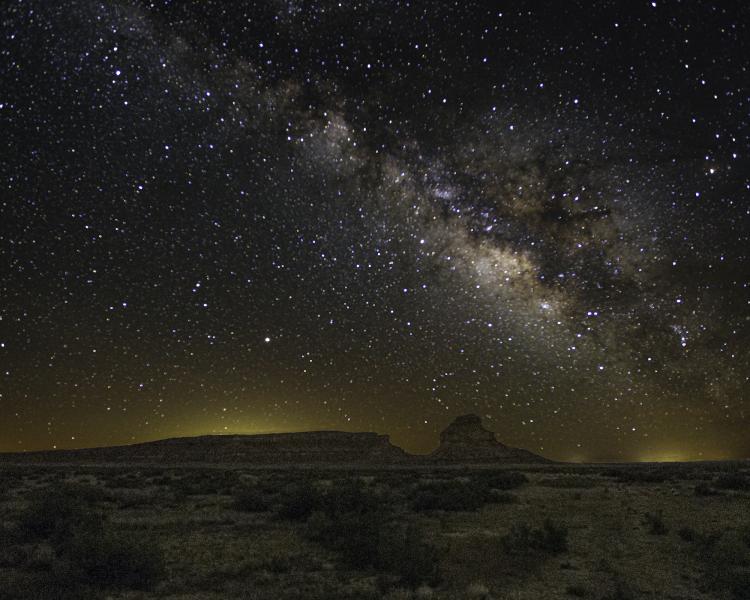Winter solstice dawn from Flagstaff Mountain amphitheater
My viewing of winter solstice dawn was quiet, but I had the conviction that this sort of observation reached far back into history, all around the world
From Flagstaff Mountain at 6:40 a.m., a brilliant red ceiling of clouds was visible over the eastern plains, while a few cumulus clouds glowed faintly overhead. The date was Dec. 21, while the occasion was winter solstice, the shortest day of the year.
The stone benches of the amphitheater were in the foreground and beyond them the lights of Boulder glowed brightly. Fall would end and winter would begin shortly, at 8:59 a.m. Mountain time. It was a stunning scene and a silent but significant event that could be traced far back into time.
The Earth takes one year to rotate around the sun, and because the earth’s axis is tilted 23.5 degrees with respect to the plane of its orbit, the sun’s azimuth — or apparent position of rising — changes each day, as do the length of the days.
In the Northern Hemisphere, winter solstice is the day when the sun rises and sets farthest to the south, about 30 degrees south of the east-west (90-270 degrees) line, while summer solstice is the longest day because the sun rises and sets about 32 degrees north of the east-west line. Spring and fall (vernal and autumnal) equinoxes are the days when the sun rises in the east at 90 degrees and sets in the west at 270 degrees, so the lengths of day and night are equal.
Three years earlier I had been at Chaco Culture National Historic Park on the Navajo Nation to photograph several of Chaco Canyon’s Great Houses and Fajada Butte. Most of the Great Houses were built between 850 and 1130 A.D., and they are huge and majestic. For example, Pueblo Bonito, the largest of the Great Houses, is a tiered structure four and five stories tall containing 695 rooms and 32 kivas (circular, sunken rooms for communal ceremonies).
At the southern end of Chaco Canyon, Fajada Butte rises 393 feet above the canyon floor. At its summit, three tall boulders cast shadows creating slivers of light that move across the upper surface of the Butte. Chacoans cut two spiral petroglyphs that catch slivers and shafts of light that fall on particular dates."
The major walls of most of the Great Houses are aligned with the cardinal directions (north, south, east, west) or with the solstice axis, which is a line from azimuth of sunrise on the longest day to the azimuth of sunset on the shortest day. Note also that a structure aligned with cardinal directions is also aligned with spring and fall equinoxes.
At the southern end of Chaco Canyon, Fajada Butte rises 393 feet above the canyon floor. At its summit, three tall boulders cast shadows creating slivers of light that move across the upper surface of the Butte. Chacoans cut two spiral petroglyphs that catch slivers and shafts of light that fall on particular dates.
The most famous feature of this light show is the Sun Dagger, a shaft of light that precisely bisects one of the petroglyphs on the summer solstice. Other patterns of light are seen only during winter solstice or the equinoxes.

At the top of the page: At dawn on winter solstice, sunrise is seen from Flagstaff Amphitheater above Boulder. Above: The Milky Way above Fajada Butte, Chaco Canyon. Photos by Jeff Mitton
The ceremonial significance of this site and its importance to Chacoans was indicated by the construction of a wooden ramp, 755 feet long and 312 feet high, that allowed all people to access the site. This was long ago, but observances of solstices and equinoxes reach further back in time.
Stonehenge, in Southern England, is an ancient feature that served as a burial site and a center for communal celebrations from 5,500 years ago to the present. The particular site was chosen because it had natural stone ridges aligned with the solstice axis. Two concentric circles were created with immense stones, some 13 feet tall, 7 feet wide and weighing 25 tons. Stones for the inner circle were smaller, but were brought from a site in Wales, 150 miles distant. The erected stones emphasized the natural alignment with the winter solstice.
Stonehenge clearly demonstrated the significance of celestial cycles as far back as 5,500 years, but Stonehenge was not alone. Contemporary sites designed to recognize cardinal directions, lunar and solar cycles and serving as a calendar include the Temple of the Sun at Machu Picchu in Peru, Newgrange in Ireland, Maeshowe in Scotland, the Mnajdra Temple in Malta and the Great Sphinx and Pyramid of Khafre in Egypt. But are these the earliest structures demonstrating awareness and significance attributed to solar and lunar cycles?
A tantalizing and still controversial megalithic structure was discovered in South Africa in 2003. Adam’s Calendar in Mpumalanga, South Africa, is a circle of standing stones almost 100 feet in diameter. It is a functional calendar with a variety of astronomical alignments, notably the cardinal directions and both summer and winter solstices. The age of Adam’s Calendar has been estimated to be at least 75,000 years. It is now protected as part of the Blue Swallow Natural Heritage Site.
Remember that modern humans first appeared in southern Africa 200,000 years ago. If the estimated age and interpretation of Adam’s Calendar are correct, then our ancient ancestors were observing and marking solstices and equinoxes, and building clocks with rocks before they even migrated to the Fertile Crescent and Europe.
My viewing of winter solstice dawn was quiet, but I had the conviction that this sort of observation reached far back into history, all around the world.

